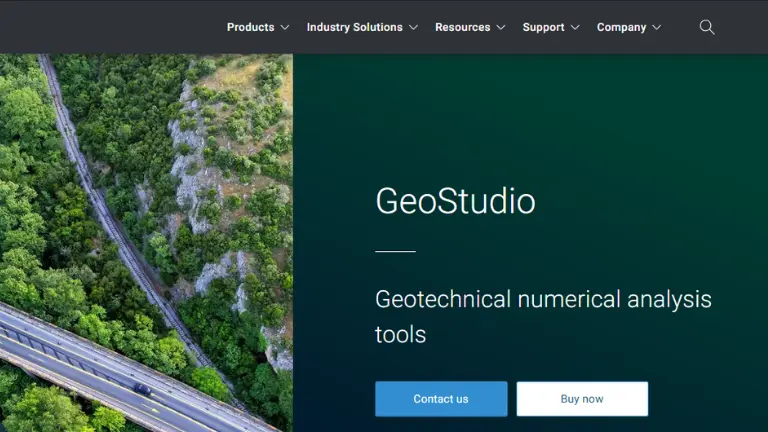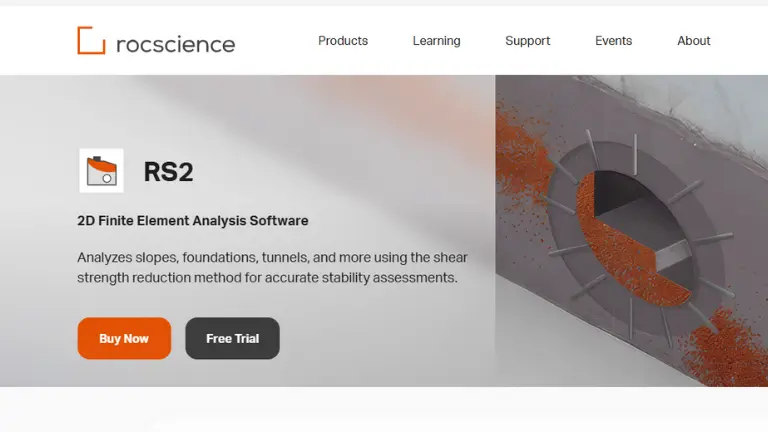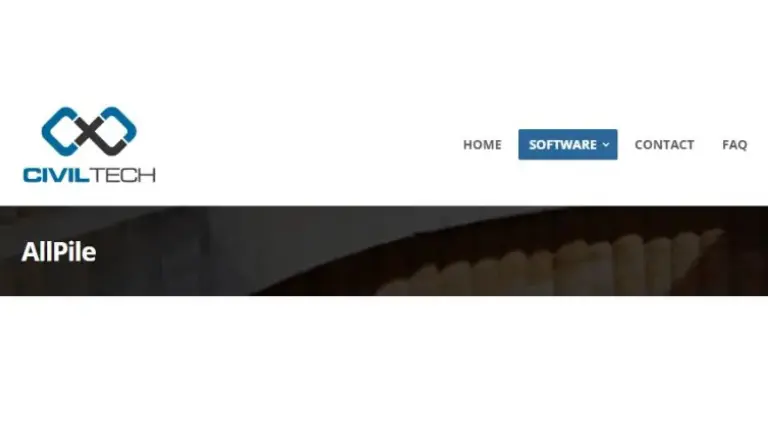Finite element analysis serves as a vital tool for geotechnical engineers, who use it to study how soil and rock elements react under different load conditions. Finite element analysis in Geotechnical engineering studies each part of complex geological systems to discover how the ground reacts under pressure.
Engineers use this computing system to find solutions related to soil strength, along with other foundation skills. Engineers use FEA to discover hazards at work and create better designs while making structures safer through construction phases, which saves construction money and time.
What is Finite Element Analysis in Geotechnical Engineering?
Geotechnical engineering uses computer-based Finite Element Analysis (FEA) to simulate how soil, rock, and structures behave under load circumstances. The system splits complicated ground designs into smaller parts to measure force movement and material response. GEA assists engineers in checking ground stability since it shows where and how ground movement occurs when soil reacts to external forces.
Applications of Finite Element Analysis in Geotechnical Engineering
Geotechnical engineering simplifies complex domains into manageable elements to create detailed simulations of different scenarios. The following list shows useful geotechnical finite element analysis applications that bring significant impacts.
1. Slope Stability Analysis
Finite element analysis performs essential work in geotechnical engineering by analyzing slope stability. By using FEM, engineers can build digital representations of natural and constructed slopes that undergo multiple loading scenarios and weather patterns. Preliminary assessments of failure surfaces combined with factor of safety determinations and deformation pattern identification provide crucial information needed for landslide prevention and safe design.
2. Foundation Design
Geotechnical engineering professionals use the FEM to examine shallow and deep foundation structures. Using FEM, engineers can analyze footings, piles, and raft foundations alongside their response to different static and dynamic loading scenarios. The method provides vital data to evaluate foundation loading capacity alongside soil settlement values and ground stress patterns.
3. Excavation and Retaining Structures
The design phase of excavations and retaining systems, including diaphragm walls, sheet piles, and soldier piles, depends heavily on geotechnical finite element analysis. Through FEM analysis, engineers determine wall deflection patterns while estimating earth pressure distribution and evaluating soil stability to create safe excavation designs.
4. Tunneling and Underground Structures
Ground movement prediction, together with stress redistribution assessment and structure impact analysis during tunneling, requires the use of finite element analysis geotechnical engineering methods. Through FEM, tunnel designers create vital elements for lining systems, and engineers achieve underground safety and operational performance evaluations.
5. Seepage and Consolidation Analysis
FEM performs extensive modeling of seepage through embankments and foundations and runs consolidation evaluations of soil from loading. The analyses help engineers determine pore water pressure distributions alongside drainage needs and settlement predictions.
6. Earthquake and Dynamic Analysis
The implementation of the finite element method in geotechnical engineering produces excellent results when analyzing dynamic loads like earthquakes. The method enables predictions about soil liquefaction alongside ground-shaking effects and geotechnical structure behavior during seismic loading events.
Read more: Abaqus – Simulation Software for Geotechnical Engineering
Advantages of Using the Finite Element Method in Geotechnical Engineering
Geotechnical engineering requires a thorough analysis of soil and structure interaction to guarantee stable and secure infrastructure construction. FEM represents a critical computational methodology that engineers use to address complex geotechnical problems in their field. The following list includes the main advantages of FEM applications in geotechnical engineering.
1. Accurate Soil-Structure Interaction Modeling
Geotechnical finite element analysis excels at modeling complex soil-structure interactions with superior precision. Engineers use this methodology to model how soil structures react under load by factoring in both soil property fluctuations and environmental elements. Such modeling predictions allow engineers to determine settlement values as well as deformation patterns and stress patterns needed for design decisions.
2. Handling Complex Geometries and Boundary Conditions
Real-world projects benefit strongly from finite element analysis in geotechnical engineering because it can properly model complex geometries plus boundary conditions that occur naturally in fieldwork. FEM models complex foundation shapes and challenging subsurface profiles and groundwater conditions using flexible algorithms that prevent accuracy-compromising simplifications.
3. Better Design Optimization
The implementation of the finite element method in geotechnical engineering generates detailed information about failure potential while it predicts settlement rates and shows stress patterns. Through FEM analysis, engineers evaluate various foundation and slope designs to find solutions that maximize effectiveness and minimize costs.
4. Improved Risk Assessment
Geotechnical analysis correctly predicts how soil-restrained structures perform under different load applications to determine failure risks and prevent major deformations. Engineers can determine needed safety precautions through this approach, thus preventing major construction and service-life failures of their structures.
5. Time and Cost Efficiency
FEA in Geotechnical engineering through sophisticated software and expert knowledge leads to minimized costs and reduced testing time for physical investigations and site evaluations. Engineers can identify potential issues before beginning construction by using FEM simulations to provide valuable design-phase insights.
List of Finite Element Analysis Software for Geotechnical Engineering
1. PLAXIS
Bentley Systems created PLAXIS as the market leader in infrastructure software worldwide. Many experts use PLAXIS for geotechnical research, especially when studying soil and rock materials.
Users can study soil behavior at a fine level through advanced mechanical modeling. PLAXIS 2D/3D functions effectively as it provides accurate results about how groundwater moves through different soil layers while handling foundation designs and ground stability challenges. The software is often applied in real-world scenarios such as analyzing slope stability, tunnel behavior, and retaining wall structures, using either PLAXIS 2D or PLAXIS 3D, depending on the complexity of the project.
Civil and geotechnical engineers select this tool because of its easy-to-use design and powerful analysis abilities. This software solution makes engineering projects safer and more dependable by lowering the chances of risks. Learn the various uses of PLAXIS software in 2D/3D with our PLAXIS 2D/3D Training Online.
2. SIMULIA ABAQUS
Under the SIMULIA brand, they created ABAQUS, which functions as a highly effective FEA tool. The industry uses this tool both for automobile production and aerospace components and it performs well in geotechnical engineering applications.
ABAQUS analyzes how soil affects different kinds of structures. The system does advanced calculations for dynamic events and nonlinear studies that benefit earthquake engineering and deep foundation work. The software shows precise results and lets users model varied materials plus loading setups.
Through ABAQUS, engineers can examine design materials digitally, which lowers hardware testing costs and speeds up their evaluation process. Everybody depends on it both in university and professional settings. Learn Abaqus Software with our Abaqus Training.
3. FLAC
Itasca Consulting Group developed FLAC as part of their sophisticated geomechanical software programs. Engineers choose this product for projects that need soil stability analysis in construction, mining, and earthwork science. FLAC excels at dynamic problems, including landslides, because its finite difference method technology fits perfectly with unstable ground analysis.
Engineers need this tool to properly display the way soil and rock react under different stress situations. Engineers apply FLAC extensively to design tunnels, support slopes, and evaluate foundations as their go-to software for these purposes.
Its core capability is to manage major deformation movements when handling materials that undergo time-based changes for difficult geotechnical projects.
4. GeoStudio
Seequent, the development unit of Bentley Systems, produces GeoStudio as their product. It provides engineers with a group of programs to model geotechnical and geo-environmental systems. Using GeoStudio allows users access to multiple software tools, including SLOPE/W for slope evaluations, SEEP/W for groundwater analysis, and SIGMA/W for stress-deformation studies.
Engineers depend on GeoStudio to evaluate the stability of earth dams and embankments, along with studying foundation properties. Its platform design lets engineers run several analysis tasks together in one project to provide better accuracy and reliability.
GeoStudio plays a key role because it shows soil behavior under different conditions. The application helps create safe and lasting designs through accurate simulation methods.
5. RS2
RS2 software creation comes from Rocscience, a dynamic Canadian geotechnical tool manufacturer. RS2 is a computer program that runs 2D analyses of soil and rock slopes, together with excavations and tunnels. It supports additional types of structures. RS2 software works with three key functions: it analyzes pressure, moves water, and deals with force changes over time.
As a popular geotechnical tool, RS2 provides users both basic functionality and extensive advanced features. RS2 helps engineers determine better soil and rock response predictions during construction projects.
The software enhances design quality and reduces risks through its advanced features in difficult underground settings. RS2 serves as a primary technology asset for both industry experts and trained students within infrastructure development.
6. GEO5
Fine Software produces GEO5 in its capacity as a Czech software development company with expertise in geotechnical technology. With GEO5, you get a range of special programs to analyze foundation engineering projects such as retaining walls, sloping ground stability, and foundation movement.
The application combines basic engineering procedures with FEM analysis for evaluation. GEO5 offers an easy-to-use platform that provides beginner-friendly step-by-step instructions to users. It provides fast and dependable analysis tools for normal daily geotechnical work.
The system allows users to install only specific tools for their needs. GEO5 makes projects run faster and safer because it provides precise calculation and reporting solutions.
7. MIDAS GTS NX
South Korean software company MIDAS IT creates the program MIDAS GTS NX for its users. The company GTS NX designs and studies tunnel projects and soil mechanics. It performs soil structure interaction analysis of slopes and tunnels and handles all their related calculations based on the finite element method.
The system lets users create 3D models and model complex soil actions. The system offers advanced analysis tools that work smoothly with its modern, user-friendly design. GTS NX connects reliably with other MIDAS technologies, which positions it favorably for large infrastructure projects. Engineers depend on GTS NX to make quick and precise decisions regarding geotechnical projects with difficult conditions.
8. ALLPILE
The US-based Ensoft company develops ALLPILE, which specializes in foundation analysis software. ALLPILE thoroughly examines and designs pile foundation systems. The program works with piles that support loading in three directions, whether in groups or as single units.
The program evaluates data for various soil depths and also recognizes pile designs under multiple loading situations. This tool helps people design pile foundations safely by making difficult computations easier.
Many engineers working with bridges, buildings, and offshore structures choose the software because it fits their needs. Its quick, efficient analysis combined with simple operation makes ALLPILE a trusted system for any foundation engineering project, no matter its size.
Conclusion
Geotechnical engineering has advanced significantly because finite element analysis shows engineers precise ways for understanding combined soil and structure performance. The simulation tool helps create better designs by testing diverse situations to ensure safety and performance improvements.
PIGSO LEARNING helps students develop leading geotechnical analysis knowledge while specializing in FEA techniques through extensive training programs. Take your first step toward career growth today by learning from PIGSO LEARNING experts.
FAQs
Q1 What does finite element analysis (FEA) do in geotechnical engineering?
In geotechnical engineering, FEA uses digital methods to represent soil, rock, and construction pieces under load to predict their behavior.
Q2 Why do engineers use FEA in geotechnical projects?
FEA allows engineers to study soil patterns while enhancing designs and making sure structures withstand various forces.
Q3 What kinds of geotechnical design projects need FEA analysis?
Geotechnical engineering projects succeed because FEA helps design foundations and analyze slope safety, plus tunnel excavations and earthquake effects.
Q4 What are the leading FEA systems used for geotechnical engineering?
Different companies like PLAXIS, ABAQUS, FLAC, GeoStudio RS2, GEO5, MIDAS GTS NX, and ALLPILE develop FEA software to solve geotechnical engineering problems.
Q5 What advantages do engineers gain when they use FEA with their projects?
The analysis results from FEA assist engineers in making better design choices because the tool creates reliable output about material stress and movement with good stability.
I’m a passionate content writer who crafts compelling, audience-focused content. I specialize in turning ideas into engaging words, ensuring every piece delivers value, connects, and drives results.











